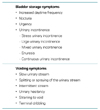Voiding Dysfunctions in Primary Care Practices
Article information
Abstract
The availability of new urologic medications has made it possible to manage a variety of urologic disorders successfully in a primary care setting. As a result, primary care physicians(PCPs) need to be familiar with the terminology and screening instruments used by urologists to decipher and categorize urologic symptoms. PCPs are often responsible for the treatment of lower urinary tract symptoms and benign prostatic hyperplasia(BPH). Evolving strategies of management include utilization of both symptom-modifying treatment and disease-modifying treatment. Alphablockers excellently provide symptomatic treatment, but do not alter long-term disease progression. 5-α reductase inhibitors can reduce the need for surgical intervention and the incidence of acute urinary retention. The combination of alphablockers and 5-α reductase inhibitors would be the choice of therapy in some patients, typically those with large prostate glands indicative of disease progression. Overactive bladder(OAB) is defined as urinary urgency with or without urge incontinence, usually with frequency and nocturia, in the absence of a pathologic or metabolic condition that can explain these symptoms. The diagnosis of OAB should be made after a careful history taking, physical examination, laboratory evaluation, and use of tools such as voiding diaries. Anticholinergic agents are the first choice for drug therapy. Treatment that couples drug therapy with behavioral techniques aimed at modifying abnormal voiding patterns may provide the best outcomes in many patients with OAB. There are situations for referring patients to urologists for more detailed evaluation and management, including when the PCP has a lack of interest in or sufficient knowledge about lower urinary tract symptoms and if the patient shows a poor response to prior noninvasive therapy, requiring in-depth investigation.










